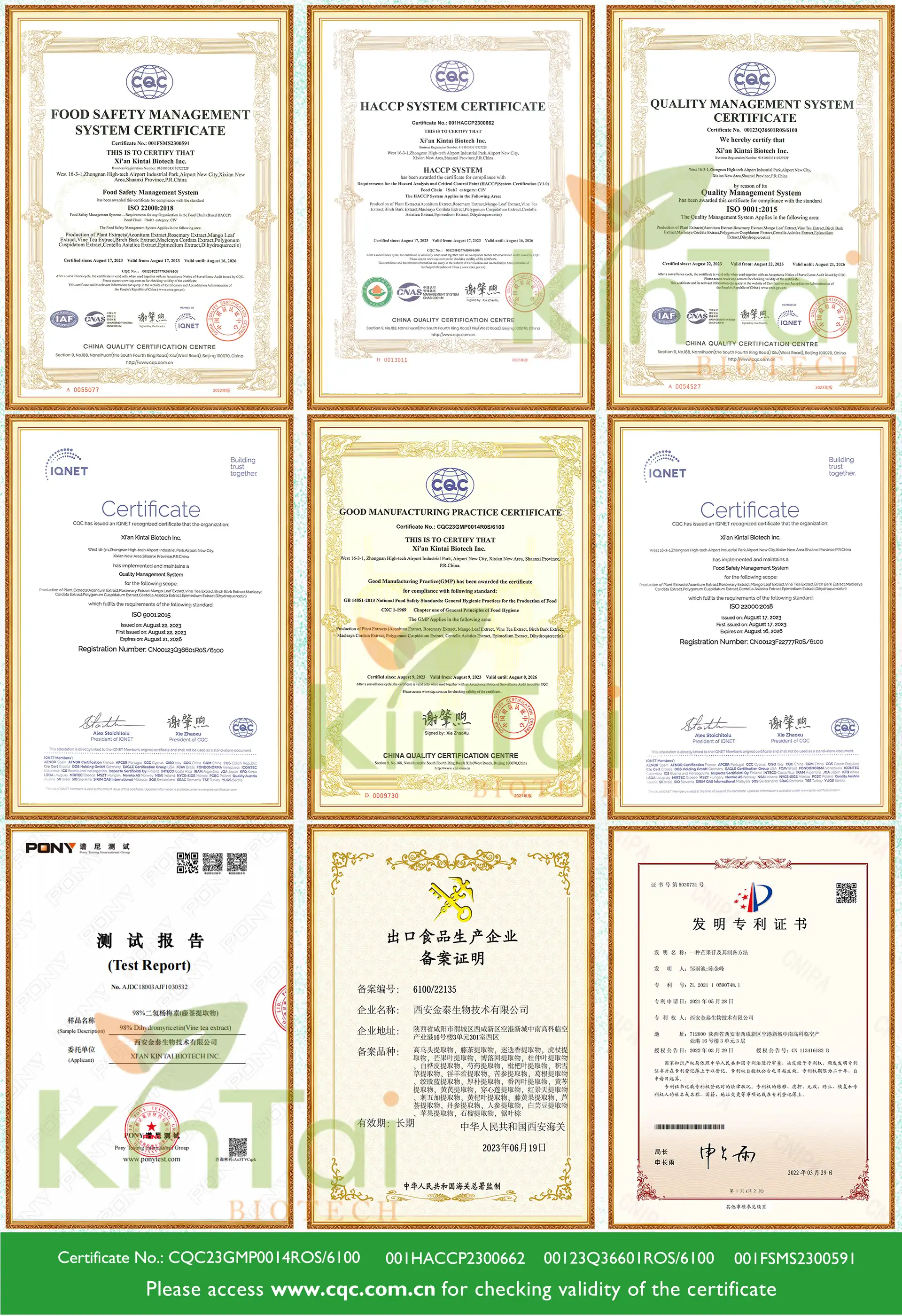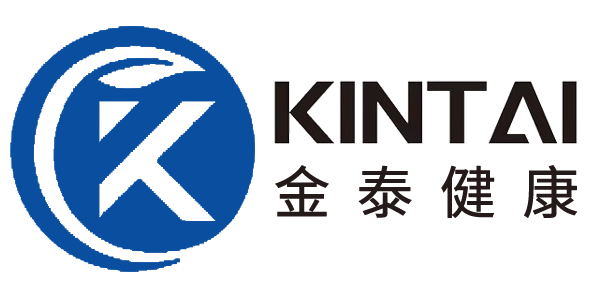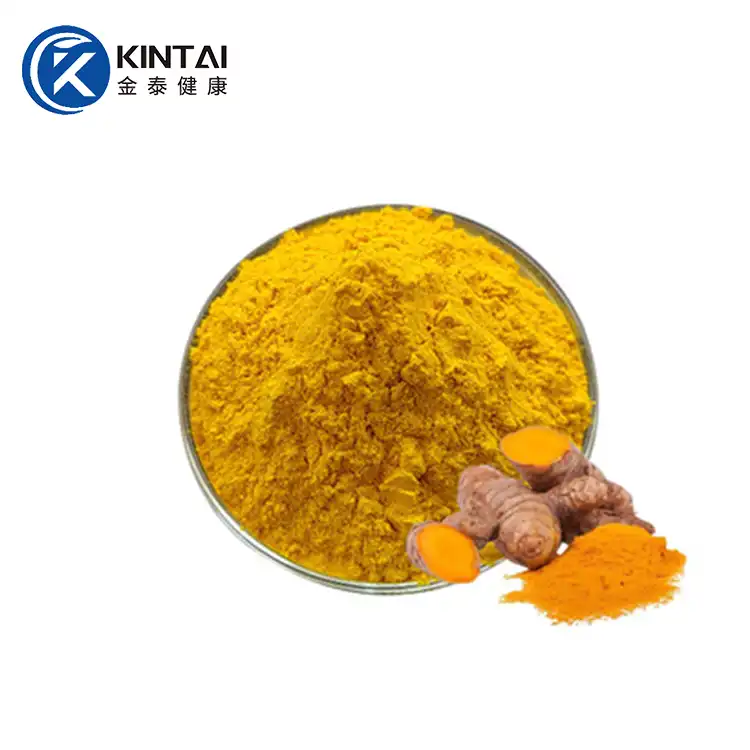Curcumin Pigment
Appearance: yellow powder
Certifications: GMP, ISO9001:2015, ISO22000:2018, HACCP, KOSHER and HALAL.
MOQ: 1KG
Sample: Free sample available
Production Capacity: 1000KG/month
Delivery Time: Delivery within one day from the warehouse
Shelf Life: Three years
MOQ: 1KG
Storage: cool, dry place and avoid light
Payment: Multiple terms acceptable like T/T, LC, DA
Company Advantage:100,000 level clean production workshop, Non-additive, Non-GMO, Non-Irradiated/treat by heat only
- Fast Delievery
- Quality Assurance
- 24/7 Customer Service
Product Introduction
Curcumin Pigment manufacturer and Supplier
Curcumin is a rare, orange-yellow crystalline diketone extracted from the ginger family. As a highly practical and safe natural pigment, curcumin is widely used in food, pharmaceuticals, cosmetics, textiles, and livestock production.

Kintai Curcumin Pigment is a natural pigment extracted from the rhizome of the turmeric plant. Its coloring power significantly outperforms many synthetic and other natural pigments, reaching 3 to 4 times the coloring power of tartrazine and sunset yellow, demonstrating exceptional dyeing performance. Kintai's food-grade curcumin is highly safe and fully complies with food and beverage industry standards, making it suitable for a wide range of related products. If you require high-quality curcumin, please feel free to contact us.
Specification
|
Specification |
Note |
|
10% Curcumin |
commonly used in dietary supplements and functional foods |
|
95% Curcumin |
widely used in the food industry as a natural colorant and flavoring agent |
|
98% Curcumin |
used in pharmaceutical applications and medicinal formulations |

Sample available! Contact us now>>>
Performance improvement of natural curcumin
Curcumin, a natural pigment with high practical value and safety, is widely used in food, pharmaceuticals, cosmetics, textiles, livestock production, and other fields. Using MOF materials to encapsulate curcumin is a simple and feasible new approach that can effectively address these issues. The feasibility of MOF materials for encapsulating and protecting natural pigments has been demonstrated. Future research will focus on screening MOF materials with excellent physicochemical properties and low toxicity to encapsulate curcumin, improving its stability and dyeing properties, and ultimately making Curcumin Pigment a well-compatible natural dye for textile coloring.

(Reference:Research progress on application and performanceimprovement of natural curcumin,ZHAO Hudie1, YI Fan1, MA Yue2, WANG Xuemei1,3, HONG Guoying1,ZHANG Dongdong1, HE Jixiang1)
Curcumin Pigment Uses
Food and Beverage: This is the most traditional application area for curcumin. It is commonly used to impart a bright, stable yellow hue to candies, ice cream, jellies, juices, dairy products, condiments (such as mustard and curry powder), and baked goods. As a natural colorant, it effectively replaces synthetic colors like tartrazine and sunset yellow, meeting consumer demand for clean labels.
Health Supplements and Pharmaceuticals: Curcumin, the core ingredient in curcumin, has attracted significant attention for its potent antioxidant and anti-inflammatory properties. It is formulated into various dietary supplements, such as capsules and tablets, to help relieve joint inflammation, protect the liver, promote digestion, and support overall immune health. Extensive research is also exploring its potential for preventing and supporting the treatment of certain chronic diseases.
Cosmetics and Personal Care: In cosmetics, curcumin is used as a natural colorant in products such as foundation, lipstick, and blush. Its anti-inflammatory and antioxidant properties also make it a functional ingredient for skincare products with soothing, brightening, and anti-aging benefits.
Other fields: In addition, curcumin is also used as a natural dye in the textile industry to dye fabrics and as a chemical indicator in the laboratory.

Curcumin Pigment Side Effects
1. Safety in Food Applications (Generally Recognized as Safe)
Regulatory Status: Major global regulatory agencies, including the Codex Alimentarius Commission (CODEX), the U.S. Food and Drug Administration (FDA), the European Food Safety Authority (EFSA), and the National Health Commission of China, have approved curcumin as a natural food colorant for use in designated food categories.
2. High-Dose Supplementation and Potential Risks
Extreme caution is advised when taking high-concentration curcumin supplements for health purposes:
Gastrointestinal discomfort: This is the most common adverse reaction. High doses of Curcumin Pigment may cause stomach discomfort, nausea, diarrhea, or acid reflux.
Impact on Drug Metabolism: This is the most concerning risk. Curcumin may inhibit the activity of certain drug-metabolizing enzymes in the liver (such as CYP450), thereby affecting the efficacy or increasing the toxicity of other medications. Particular caution is advised when taking curcumin with anticoagulants (such as warfarin), diabetes medications, and certain chemotherapy drugs.
3. Risks in Specific Populations:
Pregnant and lactating women: Due to a lack of sufficient safety data, it is generally recommended that these individuals avoid taking high-dose curcumin supplements. However, curcumin is safe for normal cooking and seasoning.
Patients with biliary tract diseases: Curcumin may stimulate bile secretion. Patients with gallbladder diseases (such as gallstones and biliary obstruction) should use curcumin under the guidance of a physician.

Why choose Kintai Curcumin Pigment?
Complying with Strict International and Domestic Standards:Kintai Curcumin fully complies with China's GB 1886.76-2015 and GB 2760-2014, the US GRAS certification, and food safety regulations in multiple countries, including the EU, South Korea, and Japan. Its safety has been evaluated by internationally recognized organizations such as JECFA, and an Acceptable Daily Intake (ADI) has been established based on reproductive toxicity studies. This fully demonstrates Kintai Curcumin's high safety and global compliance as a natural colorant, making it a trusted, high-quality choice.
Excellent Coloring Strength and Stability:Kintai Curcumin exhibits exceptional coloring power, particularly in protein-based foods, achieving uniform and long-lasting coloring. This property makes it widely applicable in the food industry, effectively meeting color requirements for a wide range of products.
OEM&ODM Service:Through modern technologies such as microencapsulation and nanocompositing, Kintai has significantly enhanced the antioxidant properties of curcumin, ensuring optimal coloring and preservation. In addition, Kintai also provides water-soluble and oil-soluble product series that can flexibly adapt to different food processing environments and process requirements, providing customers with comprehensive solutions.

FAQ
Q1:Can turmeric cause pigmentation?
A1:Turmeric works as a skin lightening agent for your skin.
Q2:Can turmeric cause skin discoloration?
A2:Turmeric root extract contains curcuminoids, a mixture of diferuloymethane derivatives that gives it its yellow pigment. Topical application of curcuminoids to the human skin is joined by orange-yellow discoloration.
Our Certifications

Send Inquiry
You May Like
0

_1760426353780.webp)
